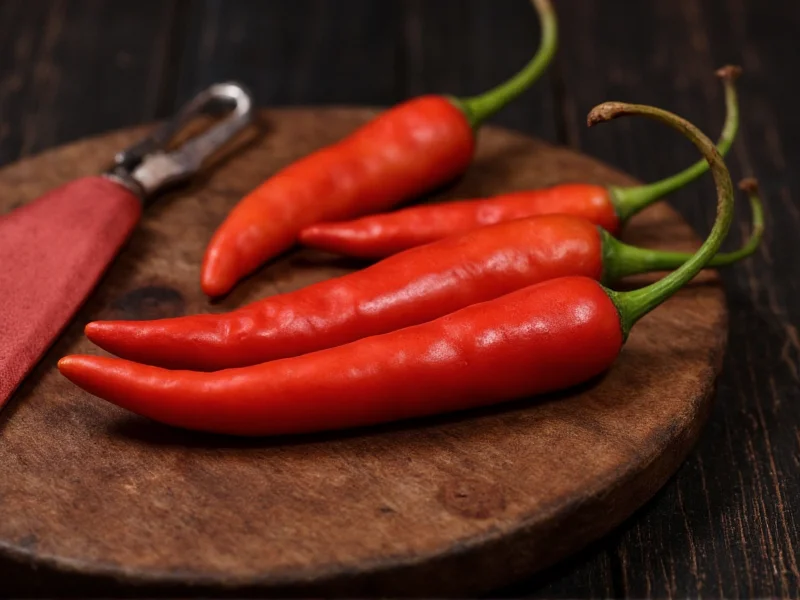Understanding the Science Behind Chile Heat Measurement
Chile pepper heat comes from capsaicinoids, chemical compounds concentrated in the white pith and seeds of peppers. The Scoville Organoleptic Test originally measured heat through human taste panels diluting pepper extracts until heat was no longer detectable. Today, High Performance Liquid Chromatography (HPLC) provides precise laboratory measurements of capsaicin concentration, which are then converted to Scoville Heat Units for consumer understanding.
Modern chile heat scale interpretation requires understanding that heat perception varies significantly between individuals due to genetic differences in TRPV1 receptors. What registers as moderately hot to one person might be extreme to another. Environmental factors like growing conditions, soil composition, and water stress also cause natural variation in heat levels within the same pepper variety.
Comprehensive Chile Pepper Heat Reference Chart
| Pepper Variety | Scoville Heat Units (SHU) | Heat Level Classification | Common Culinary Uses |
|---|---|---|---|
| Bell Pepper | 0 SHU | Mild | Raw in salads, stuffed dishes |
| Pepperoncini | 100-500 SHU | Mild | Pickled appetizers, Greek salads |
| Jalapeño | 2,500-8,000 SHU | Medium | Salsas, nachos, poppers |
| Serrano | 10,000-23,000 SHU | Hot | Pico de gallo, hot sauces |
| Habanero | 100,000-350,000 SHU | Very Hot | Caribbean cuisine, hot sauces |
| Ghost Pepper (Bhut Jolokia) | 800,000-1,041,427 SHU | Extreme | Competitive eating, specialty sauces |
| Carolina Reaper | 1,400,000-2,200,000+ SHU | Ultra Extreme | Pepper challenges, extract production |
Factors Influencing Chile Pepper Heat Levels
Several variables affect the actual heat measurement of chile peppers beyond their genetic potential. Understanding these factors helps explain why heat levels can vary significantly even within the same variety:
- Growing conditions: Stressors like drought, temperature fluctuations, and nutrient deficiencies increase capsaicin production as a defense mechanism
- Ripeness: Fully ripe peppers generally contain higher capsaicin concentrations than immature ones
- Plant position: Peppers growing in direct sunlight typically develop more heat than shaded counterparts
- Part of the pepper: The placenta (white pith) contains the highest concentration of capsaicin, not the seeds as commonly believed
- Preparation methods: Cooking techniques like roasting or boiling can reduce perceived heat by breaking down capsaicin
Practical Applications of the Chile Heat Scale
Knowing how to interpret the chile heat scale chart provides valuable guidance for culinary applications. When substituting peppers in recipes, understanding relative heat levels prevents disappointing or uncomfortably spicy results. For example, replacing jalapeños with serranos in a salsa recipe will significantly increase heat intensity, while substituting poblanos for jalapeños creates a milder dish.
Food manufacturers use precise chile heat measurement to maintain consistent product quality across batches. Hot sauce producers carefully blend peppers of known Scoville ratings to achieve target heat levels. Home cooks benefit from understanding that removing seeds and membranes reduces heat without sacrificing flavor, as these parts contain the highest capsaicin concentration.
Safety considerations are crucial when handling extremely hot peppers. Always wear gloves when preparing habaneros or hotter varieties, and avoid touching your face. If experiencing excessive heat after consumption, dairy products like milk or yogurt provide relief by binding to capsaicin molecules, while water merely spreads the sensation.
Limitations and Evolution of Heat Measurement
While the Scoville scale remains the standard reference for chile heat comparison, it has limitations. The original human-taster method produced inconsistent results due to individual tolerance variations. Modern HPLC testing provides objective measurements but doesn't perfectly correlate with human perception of heat.
Researchers continue developing more accurate measurement systems that account for individual physiological differences. Some propose incorporating trigeminal nerve response measurements alongside capsaicin concentration for a more comprehensive understanding of perceived heat. Despite these advancements, the Scoville scale remains the most widely recognized and practical reference for consumers and culinary professionals.
Frequently Asked Questions About Chile Heat Scale
How is the Scoville scale measured today?
Modern Scoville measurements use High Performance Liquid Chromatography (HPLC) to precisely quantify capsaicinoid concentration in pepper samples. The results are then mathematically converted to Scoville Heat Units (SHU) for consumer understanding, replacing the original subjective human taste panel method.
Why do some jalapeños taste hotter than others?
Jalapeño heat variation (2,500-8,000 SHU) results from growing conditions, ripeness, and plant genetics. Stressors like drought increase capsaicin production, while fully ripe red jalapeños are typically hotter than green ones. Individual pepper placement on the plant also affects heat levels.
What's the difference between Scoville units and pure capsaicin?
Pure capsaicin measures approximately 16 million Scoville Heat Units. The Carolina Reaper, currently the world's hottest pepper, ranges from 1.4-2.2 million SHU, meaning it contains about 7-13% the capsaicin concentration of pure capsaicin extract used in pepper sprays and industrial applications.
Can cooking reduce a pepper's Scoville rating?
Cooking doesn't change the actual Scoville rating (capsaicin concentration), but it can reduce perceived heat. Roasting breaks down some capsaicin molecules, while boiling leaches heat into cooking liquid. Adding dairy or fats during cooking binds to capsaicin, making the final dish taste less spicy even though the pepper's inherent heat remains unchanged.
Is there a limit to how hot peppers can get?
Pepper heat appears limited by biological constraints. Current research suggests peppers cannot naturally exceed approximately 2.5 million SHU, as higher capsaicin concentrations would prevent seed dispersal by deterring all potential animal carriers. The Carolina Reaper (2.2 million SHU) approaches this theoretical maximum, representing the current practical limit of naturally occurring chile heat.











 浙公网安备
33010002000092号
浙公网安备
33010002000092号 浙B2-20120091-4
浙B2-20120091-4